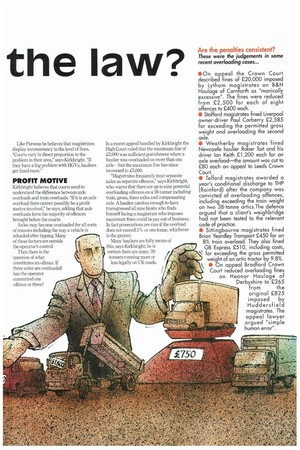Full weight a the law?
Page 40

Page 41

If you've noticed an error in this article please click here to report it so we can fix it.
The Department of Transport's campaign against overloading is to include a National Overloading Seminar addressed by Roads and Traffic Minister, Robert Key.
The seminar will take place in November, in tandem with a campaign to educate the judiciary on the potentially serious effects of running trucks overweight. The DOT seems to believe that some magistrates let hauliers off lightly because they do not treat overloading as a serious motoring offence.
A presentation to magistrates in South Wales set out to explain the "seriousness of overloading and the technical aspects of vehicle weights"; further meetings are expected throughout the UK.
But is overloading on the increase? According to the 1992/3 Vehicle Inspectorate report prohibitions for overloaded vehicles fell from 7,985 in 1991/2 to 6,987 in 1992./3, despite an increase in vehicle checks from 119,758 to 124,004.
It must be assumed that many more overloaded vehicles escape detection: the VI believes the fall in prohibitions was influenced by the lower number of vehicles stopped at ports since the abolition of cross border patrols: "Prohibitions from vehicles leaving ports have, in the past, been higher than the national average," it says.
A man with plenty of experience of stopping vehicles leaving ports is Inspector Keiron Parsons of the South-East Traffic Area, based in Portsmouth. His team heads up multi-agency checks on trucks coming in from Portsmouth and other southern ports.
He refutes the view that foreign operators are more likely to run overweight than UK operators: "Overloading offences are common to foreign and UK operators," he says' and he also disagrees with the widely held belief that foreign operators try to plead ignorance of Britain's weight regulations: "Foreign operators know the score," he says. "They know full well the maximum is 38 tonnes and if they are pulled they accept that they have to pay the penalty for it."
Hauliers, wherever they come from, share a common purpose, he adds: "They are all in business to make money and if they can get away with an extra tonne or two they will."
ACTUAL OFFENCE
This month the short-lived system of fines based on the offender's earnings will be dropped in favour of the traditional practice of basing fines on the actual offence.
But this will not change the way magistrates view overloading offences: Parsons reckons the main problem has always been inconsistency among the judiciary. "Magistrates will either be very lenient or go over the top," he says, with fines for the same offence ranging from £40 to £400. Kent County Council is taking a hi-tech approach to overloading. In a pilot scheme next year it plans to introduce weighttriggered sensor pads linked to roadside cameras. The authority will target grossly overloaded vehicles leaving its ports Last year a three-month council survey found that more than half of all foreign trucks and a third of UK trucks on its roads were running overweight. "We will be targeting the unscrupulous driver who is dangerously overloaded," says the council.
This system has not yet been suggested round Parsons' Hampshire base, but he warns that the Kent scheme could run into problems if weight samplers are interpreted as weighbridges. The law only requires a load to be weighed once, and hauliers can seek redress if they have to drive more than five miles to a weighbridge and their load proves to be legal.
But how do magistrates determine how much to fine hauliers for overloading offences? The Magistrates Association produces guidelines which make a clear distinction between offenc.es which are due to carelessness or some other factor, and those which are deemed to be "overloading for profit" and should attract much heavier fines.
Transport lawyer Stephen Kirkbright believes that this approach is "absolutely right". He believes that operators who deliberately overload to make a fast buck should be driven out of the industry
Like Parsons he believes that magistrates display inconsistency in the level of fines. "Courts vary in direct proportion to the problem in their area," says Kirkbright. "If they have a big problem with HGVs, hauliers get fined more."
PROFIT MOTIVE
Kirkbright believes that courts need to understand the difference between axle overloads and train overloads. "If it is an axle overload there cannot possibly be a profit motive involved," he says, adding that axle overloads form the majority of offences brought before the courts.
Axles may become overloaded for all sorts of reasons including the way a vehicle is reloaded after tipping. Many of these factors are outside the operator's control.
Then there is the question of what constitutes an offence. If three axles are overloaded has the operator committed one offence or three? In a recent appeal handled by Kirkbright the High Court ruled that the maximum fine of £2,000 was sufficient punishment where a haulier was overloaded on more than one axle—but the maximum fine has since increased to £5,000.
"Magistrates frequently treat separate axles as separate offences," says Kirkbright, who warns that there are up to nine potential overloading offences on a 38-tonner including train, gross, three axles and compensating axle. A haulier careless enough to have transgressed all nine limits who finds himself facing a magistrate who imposes maximum fines could be put out of business. In fact prosecutions are rare if the overload does not exceed 5% or one tonne, whichever is the greater.
Many hauliers are fully aware of this, says Kirkbright; he is certain there are many 39tonners running more or less legally on UK roads.
























































































